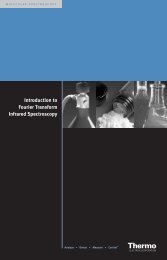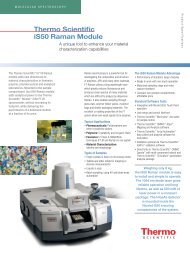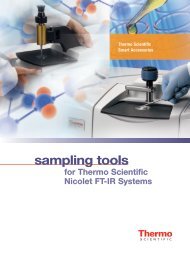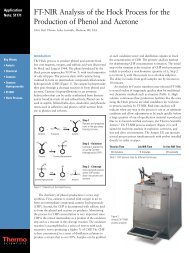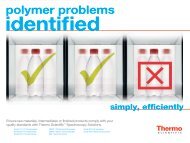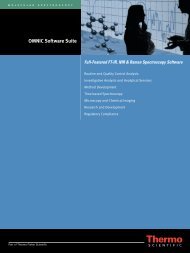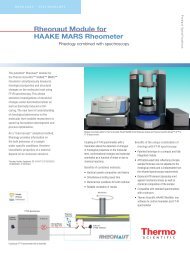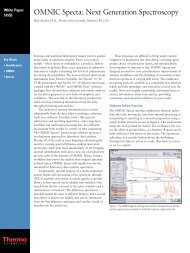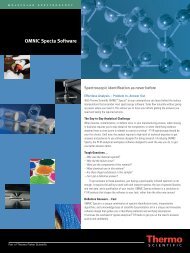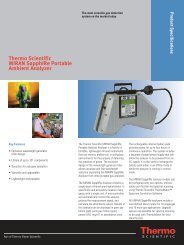The Analysis of Beer Components Using FT-NIR ... - Nicolet CZ sro
The Analysis of Beer Components Using FT-NIR ... - Nicolet CZ sro
The Analysis of Beer Components Using FT-NIR ... - Nicolet CZ sro
You also want an ePaper? Increase the reach of your titles
YUMPU automatically turns print PDFs into web optimized ePapers that Google loves.
Figure 2: Data collection from transflectance<br />
module<br />
<strong>The</strong> universal capacity <strong>of</strong> the <strong>FT</strong>-<strong>NIR</strong> technique is based<br />
on chemometrics, and allows for a correlation between<br />
the spectra and their chemical and physical properties.<br />
A calibration model was developed using the <strong>The</strong>rmo<br />
Scientific TQ Analyst s<strong>of</strong>tware package for quantitative<br />
analysis. In this application, the spectra were then analyzed<br />
quantitatively for alcohol content, color, refractive index<br />
and specific density. <strong>The</strong>se parameters were predicted using<br />
a single <strong>FT</strong>-<strong>NIR</strong> spectrum for each <strong>of</strong> the standards sample.<br />
All spectra were mean-centered and the pathlength type<br />
used was multiplicative signal correction (MSC).<br />
Partial Least Squares (PLS) calibration models were<br />
developed for all quantitative analysis. Each component <strong>of</strong><br />
this quantitative method was analyzed, using different regions<br />
<strong>of</strong> the spectra. Figure 3 shows a representative spectrum,<br />
as well as, first and second derivatives spectra used for<br />
the analysis. Table 2 summarizes the parameters used<br />
for the analysis.<br />
<strong>Using</strong> PLS regression, the <strong>FT</strong>-<strong>NIR</strong> spectra was correlated<br />
with results from reference methods to establish a model<br />
for calculation <strong>of</strong> the beer samples.<br />
Spectral Region Spectral<br />
Component <strong>of</strong> <strong>Analysis</strong> Treatment Smoothing<br />
Alcohol 5500– 4000 cm-1 First Derivative None<br />
Color 9900– 4100 cm-1 None None<br />
Refractive Index 7000– 4000 cm-1 First Derivative Norris Derivative<br />
(segment 5, gap 2)<br />
Specific Density 7162– 4099 cm-1 Second Derivative Norris Derivative<br />
(segment 3, gap 2)<br />
Table 2: Summary <strong>of</strong> the parameters used for the analysis <strong>of</strong> beer<br />
standards samples<br />
Figure 3: Representative spectrum from beer standard samples, first and second derivative <strong>of</strong> the spectrum, respectively



